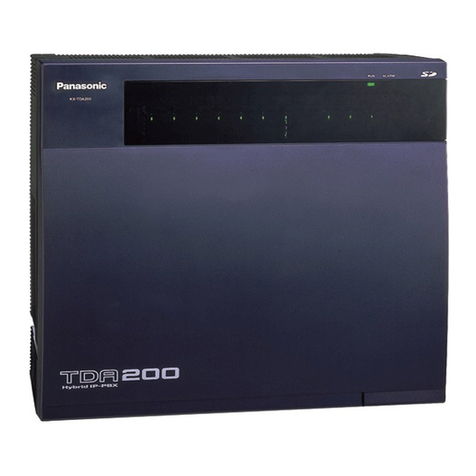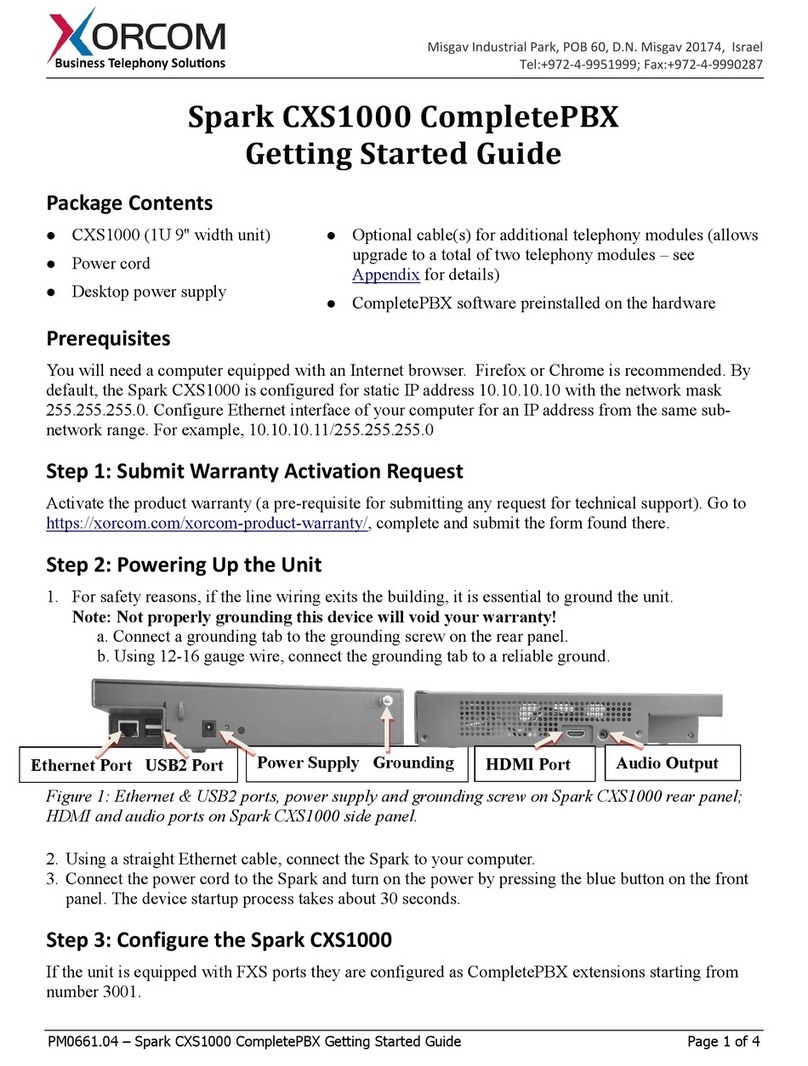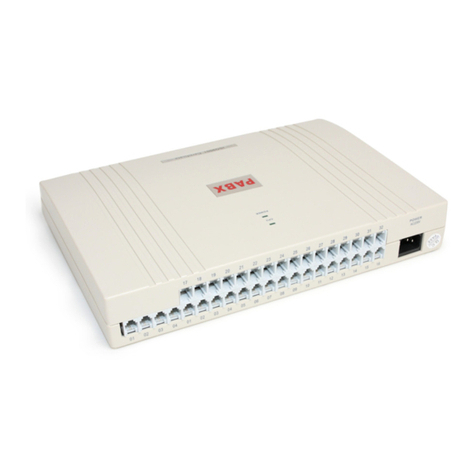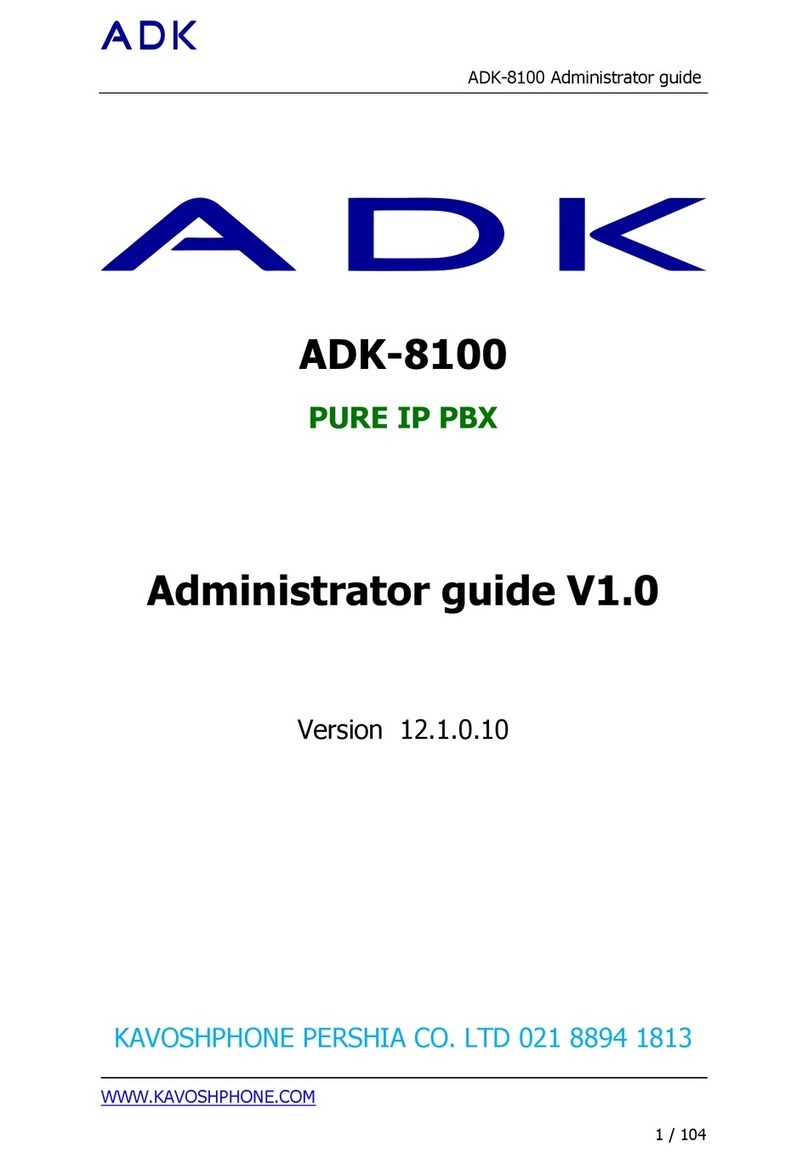Switch Voice BR4 User manual

BR4 - Appliance User Manual v2.0
Page: 1/48
USER MANUAL

BR4 - Appliance User Manual v2.0
Page: 2/48
Version History
Version Description of change
1.2 Origin
1.3 Section 2.3.1. for interface cables added
1.4 Section 3.23.1. Firmware upgrade is elaborated
1.5 Section 3.23.1. Firmware upgrade is elaborated
1.6 1.1. Echo cancellation module chapter is expanded
1.7 Section 3.23.1. Firmware upgrade is elaborated
1.8 Links are updated to point SwitchVoice Ltd. web site
1.9 Added SSH/console access information
2.0 Section 1.1 and Section 2.3.1. are updated

BR4 - Appliance User Manual v2.0
Page: 3/48
Table of Contents
Table of Contents .................................................................................................................3
1. General overview.......................................................................................................... 4
1.1. Echo cancellation module ........................................................................................... 6
2. Technical information..................................................................................................7
2.1. System: uClinux, SwitchFin......................................................................................7
2.2. Hardware:....................................................................................................................8
2.3. Interfaces.....................................................................................................................8
2.3.1. Interface cables.........................................................................................................8
2.4. Applications ..............................................................................................................10
2.5. Additional information..............................................................................................10
3. Software and Configuration tips. Working with the GUI..........................................10
3.1. System Status Menu..................................................................................................10
3.2. mISDN Config Menu................................................................................................12
3.3. Trunks........................................................................................................................15
3.4. Outgoing Calling Rules.............................................................................................17
3.5. Dial plans...................................................................................................................18
3.6. Users.......................................................................................................................... 19
3.7. Ring Groups ..............................................................................................................21
3.8. Music on Hold........................................................................................................... 23
3.9. Call Queues ...............................................................................................................24
3.10. Voice Menus ........................................................................................................... 26
3.11. Time Intervals .........................................................................................................28
3.12. Incoming Calling Rules........................................................................................... 29
3.13. Voice mail...............................................................................................................30
3.14. Conferencing...........................................................................................................32
3.15. Follow me................................................................................................................34
3.16. Directory..................................................................................................................35
3.17. Call Features............................................................................................................36
3.18. VoiceMail Groups................................................................................................... 38
3.19. Voice Menu Prompts...............................................................................................39
3.20. System Info .............................................................................................................40
3.21. Back up....................................................................................................................40
3.22. Options ....................................................................................................................42
3.23. Advanced Options...................................................................................................43
3.23.1 Updating your BR4 firmware................................................................................46

BR4 - Appliance User Manual v2.0
Page: 4/48
1. General overview
What is BR4 - Appliance?
BR4 - Appliance is a Blackfin DSP based Asterisk driven, S/T interface
embedded appliance. It is an open source embedded platform based on
uClinux and SwitchFin.
Basic Rate Interface is Integrated Services Digital Network (ISDN)
configuration that consists of two B channels (64 kbits/s “bearer” channels) used
for voice and data. And one D channel (16 kbits/s “data” channel).
The physical interface is called S/T. It uses four wires with a separate pair of
wires for the uplink and another pair for the downlink.
The typical use of the BRI interface is in residential solutions.
The mISDN ports can be configured for PTP or PTMP mode. PTP (Point to
Point) is a type of connection restricted to two end points.
PTMP (Point to Multi Point) is a type of connection, providing multiple pats
from a single point to multiple points (locations).

BR4 - Appliance User Manual v2.0
Page: 5/48

BR4 - Appliance User Manual v2.0
Page: 6/48
1.1. Echo cancellation module
Echo cancellation module installed in BR4 - Appliance
To ensure carrier grade voice quality, BR4 - Appliance can accept an
optional line echo cancellation module based on G.168 standard.
Echo cancellation is a process of removing the echo from a voice
communication in order to improve voice quality on a telephone call. In general
there are two sources of echo in the telephony: Acoustic echo and echo from the
analog phone hybrids. Speech compression techniques and digital processing
delay often make these echoes more severe in telephone networks.
To achieve consistent quality we have selected hardware based solution from
Zarlink. There is a special connector inside the BR4 - Appliance, where user can
plug an optional LEC module. If you have LEC-64-BR4 installed in your BR4 –
Appliance it will be detected and configured automatically.

BR4 - Appliance User Manual v2.0
Page: 7/48
2. Technical information
*picture without LEC module
2.1. System: uClinux, SwitchFin
Our PBXs are driven by our own telephony oriented, Open Source uClinux
distribution called SwitchFin ( http://switchfin.org). Current version of
SwitchFin provides Asterisk 1.4.x and mISDN 1.2 together with custom kernel
modules to support our hardware. Additional applications such as PPPoE, SMTP
forwarder, NTPd and many more are also provided to extend usability of the
BR4-Appliance under different scenarios.

BR4 - Appliance User Manual v2.0
Page: 8/48
2.2. Hardware:
•ADSP - BF537 600MHz CPU. DSP core for the media processing.
•64MB of SDRAM
•256KB serial flash for the boot-loader
•256MB NAND flash for voicemail and prompts.
•SD card interface on a dedicated bus.
•Watchdog timer
•Optional, hardware based, G-168 Line Echo Cancellation.
2.3. Interfaces
•QUAD ISDN (2B + 1D) interface
•TE with PTP and PTMP
•EuroISDN (mISDN)
•10/100Mbps Ethernet port with high performance PHY
•RS232 for console connectivity (115k, 8-N-1)
2.3.1. Interface cables
•For the Ethernet connection you have to use:
-In case you connect to router, switch and etc. Ethernet patch cable
-In case you connect to other PBX device crossover cable
The default SSH credentials are username: root, password uClinux
•ISDN ports – the BR4 PBX has 4 ISDN ports:
•To connect the BR4-Appliance (TE mode) ISDN port to your
telecommunication equipment you should use standard Ethernet
“patch” cable. The configuration is:
Pin Description
3 TX+
6 TX-
4 RX+
5 RX-

BR4 - Appliance User Manual v2.0
Page: 9/48
Keep in mind that if you want to use BR4-Appliance in NT mode
you will need an ISDN crossover cable as shown below (pins
enumeration according standard RJ45 male connector, see above):
You will need to use 100Ωexternal resistive termination (between
both TX+,TX- and RX+,RX-) at the NT end of the ISDN cable. For
example assume BR4-Appliance1 is set to NT mode, BR4-
Appliance2 is TE mode. We will terminate at BR4-Appliance1
side (refer to the picture above). You need to put a resistor between
pins 3-6 and another one between pins 4-5. BR4-Appliance doesn’t
provide phantom power on its ISDN ports. If you are connecting
ISDN telephone which requires power from the ISDN line you
have to implement this externally
•Serial Port cable
You need serial patch cable for the console access to your PBX from a PC.
The schematic of the cable is:
The default console port credentials are username: root, password uClinux

BR4 - Appliance User Manual v2.0
Page: 10/48
2.4. Applications
•VoIP / TDM Gateways
•PBX / IVR functionality
•VoIP Services
•Conferencing
•Custom platforms
•Voice Routing
•Custom Development
2.5. Additional information
•Power supply 6 - 12VDC
•Current consumption – 150 mA@12V
•Dumensions: 224 x 122 x 30 mm (8” 13/16 x 4” 13/16 x 1” 3/16)
•12V, 2A power adapter is included
3. Software and Configuration tips.
Working with the GUI
3.1. System Status Menu
After all the interfaces are connected and your BR4-Applinace is powered up
you can connect to the GUI through your preferred Web browser. By default all
BR4 - Appliances are preconfigured with 192.168.1.100/24 IP address/netmask.

BR4 - Appliance User Manual v2.0
Page: 11/48
Please change the IP address on the computer you will be using to configure the
BR4 - Appliance to be a part of 192.168.1.x network (for example: 192.168.1.2).
At this point you can connect to the GUI by selecting the following URL:
http://192.168.1.100
When the initial page finishes loading you will be prompted to authenticate.
Our default user name is admin and password is switchfin
After successful login, you will see the system status page.
The System Status page presents all vital information about the current state of
your BR4 - Appliance.
Here is an example with system status page of a local PBX.

BR4 - Appliance User Manual v2.0
Page: 12/48
As you can see there is one trunk bri2 in use, the type of it is BRI and its using
port 2.
The users with extensions 6204,6210 and 6250 are agents for a call center.
There is Conference room with public extension 6300 and no participants are
connected.
Different color lights indicate the state of the users.
The extension 6200 associated with user name “John Brown”, using an SIP
telephone and currently have two voicemail messages. The current state of this
user is “Available”, which indicates that the endpoint is registered and not in
use.
The extension 6204 associated with user name “Mike Reverouzzi”, using an SIP
telephone and currently have two voicemail messages. The current state of this
user is “Busy”, which indicates that the endpoint is powered and it is on a call.
The extension 6210 associated with user name “Sales Department Secretary”,
using an SIP telephone and currently have no voicemail messages. The current
state of this user is “UnAvailable”, which indicates that the endpoint is powered
down or there is some network connectivity problem.
The extension 6211 associated with user name “Sales Department Head”, using
a IAX telephone and currently have no voicemail messages. The current state of
this user is “Available”, which indicates that the endpoint is registered and not in
use.
The extension 6250 associated with user name “PR Department Head”, using an
SIP telephone and currently have three, already checked voicemail messages.
The current state of this user is “Available”. which indicates that the endpoint is
powered and not in use.
The extension 6260 associated with user name “Support Department”, using an
IAX and currently have three voicemail messages. The current state of this user
is “Ringing”, which indicates that the endpoint is powered and it is ringing
(receiving a call).
The extension 6400 is designated to Ring Group.
The extension 7000 is designated to the English language voice menu.
The extension 6221 is designated to retrieve voicemail messages.
The extension 2676 is designated to corporate directory service which can be
used in one or more IVR menus.
3.2. mISDN Config Menu

BR4 - Appliance User Manual v2.0
Page: 13/48
Keep in mind that port (s) of your PBX that you want to use, should match
configuration of your ISDN device you are connecting to. For example if you
have a mISDN phone in PTMP mode, the port of your PBX must be set to
PTMP mode as well.
By clicking on the “Edit” button a pop-up menu will appear.

BR4 - Appliance User Manual v2.0
Page: 14/48
The option here that you can use are :
•Card/Port –Gives the information about how many ports does the
appliance have and which one, you are editing.
•Port Settings – You have to select the port for PTP (Point To Point),or
PTMP (Point To Multi Point) mode.
•Port Options – you can select the port to be master clock for
synchronizing with other devices.
Creating BRI trunks:
You can see the configured trunks of your PBX, you can delete or add new
trunks. After creating new trunk you have to click the Reload button in the
GUI.
* Warning – In order for complete adding of new Trunk , after creating the
trunk you must reboot your PBX from Reboot button in to the Option Menu.
This should be done before doing any other changes in to the GUI.

BR4 - Appliance User Manual v2.0
Page: 15/48
3.3. Trunks
Click on the button in to main menu
After loading this page on the system which has not been yet configured the
following menu will appear:
If you want to setup VoIP trunk press the tab “New SIP/IAX Trunk”

BR4 - Appliance User Manual v2.0
Page: 16/48
*Reminder – You can always use the “i” (info) tooltips for additional information
•First you have to select the type of your provider as shown SIP or IAX
•Provider name – specify your provider name for reference
•Hostname – here you type the default address of your provider for
example support.provider.com
•Username – this is you username also given by the provider
•Fromuser – fill this field as per providers instructions
•Fromdomain – fill this field as per providers instructions
•Password – this is you password given by the provider
•Insecure Type – Specifies how to handle connections with peers
The above example indicated that we have on BRI trunk named “bri2” which
contains port number 2 (BRI2).
* Warning – In order for complete adding of new Trunk , after creating the
trunk you must reboot your PBX from Reboot button in to the Option Menu.
This should be done before doing any other changes in to the GUI.

BR4 - Appliance User Manual v2.0
Page: 17/48
3.4. Outgoing Calling Rules
Click on the button in to main menu
After loading this page on the system which has not been yet configured, you
will need to create a “New Calling Rule” The following menu will appear:
*Reminder – You can always use the “i” (info) tooltips for additional information

BR4 - Appliance User Manual v2.0
Page: 18/48
•At first you need to assign unique reference name to the new Outgoing
rule
•In the second field, “Pattern” standard telephony regular expression
patters needs to be specified:
X ... Any Digit from 0-9
Z ... Any Digit from 1-9
N ... Any Digit from 2-9
[12345-9] ... Any Digit in the brackets (in this example,
1,2,3,4,5,6,7,8,9
. ... Wildcard, matches anything remaining; i.e. _9011. Matches
anything starting with 9011 (excluding 9011 itself)
! ... Wildcard, causes the matching process to complete as soon as it
can unambiguously determine that no other matches are possible
For example, the extension _NXXXXXX would match normal 7
digit numbers, while _1NXXNXXXXX would represent a three
digit area code plus phone number, proceeded by a one.
•“Destination” field should be used only if you want to invoke some local
application or if the call should be processed in some special way.
•“Use trunk” indicates which trunk should be used to handle this call (ie:
“bri2”).
•“Strip” indicates how many proceeding digits should be removed from a
dialstring.
•“Failover trunk” indicates if there is an alternative trunk to be used in case
if the primary trunk is not available (in use for example).
3.5. Dial plans
The “DialPlan” page allows you to define different Classes of Service (Dial
Plans) and associate them with one or more Outgoing Calling Rules defined
in the previous step. Also, predefined local services/application can be
associated with each Class of Service.

BR4 - Appliance User Manual v2.0
Page: 19/48
•Please select a unique identifier for your Dial Plan entry.
•Select all services and rules to be available to users using this Dial
Plan entry (Class of Service).
3.6. Users
The “Users” page allows creation of user accounts (Extensions) for VoIP
accounts. Voicemail options are also configurable through this page.
*Reminder – You can always use the “i” (info) tooltips for additional information

BR4 - Appliance User Manual v2.0
Page: 20/48
General
•Extensions – this is the actual number to be dialed to reach the user,
it’s an index and it needs to be unique.
•CallerID - specifies the internal caller id number associated with this
account. This number will be used to automatically identify the user to
the voicemail system. The CallerID does not have to be unique.
•Name – Indicates the Caller ID Name which will be sent to other
callers , if the network permits such functionality.
•Outbound CallerID – indicates the public CallerID number to be used
for the outbound calls. Depending on the provisioning of your ISDN
line and/or feature set supported by your VoIP trunk providers, this
number may or may not be presented to the destination endpoint.
Enable VoiceMail for this User
•VoiceMail Access Pin Code – indicates the passcode required to
access this voicemail box.
•Mailbox – this field indicates to which mailbox number Voicemail
Indicator will subscribe. (visual indicators and stutter tone)
•Email Address – indicates an email address to be used to send
voicemail notifications and actual voicemail attachments (depends on
voicemail configuration, please refer to the applicable section below).
Technology
•SIP/IAX/Analog Station - indicates the protocol (technology) to be
used for this account. Please note that analog ports are not available on
the BR4 - Appliance.
•Flash/RxFlash – Hook flash specific parameters.
•Codec preference – list of available codecs listed in order of
preference. Please note that both ends need to agree for connection to
be established.
VoIP Settings
•MAC Address – this field is required for Polycom phone provisioning,
do not use it at this point.
•Line number – as above
•SIP/IAX password – user password associated with this account
•NAT – indicated if the device will be located behind NAT router in
respect to our BR4 -Appliance.
•Can Re-invite – indicates if SIP session can use re-invite to send RTP
directly between to endpoints.
Table of contents
Popular PBX manuals by other brands
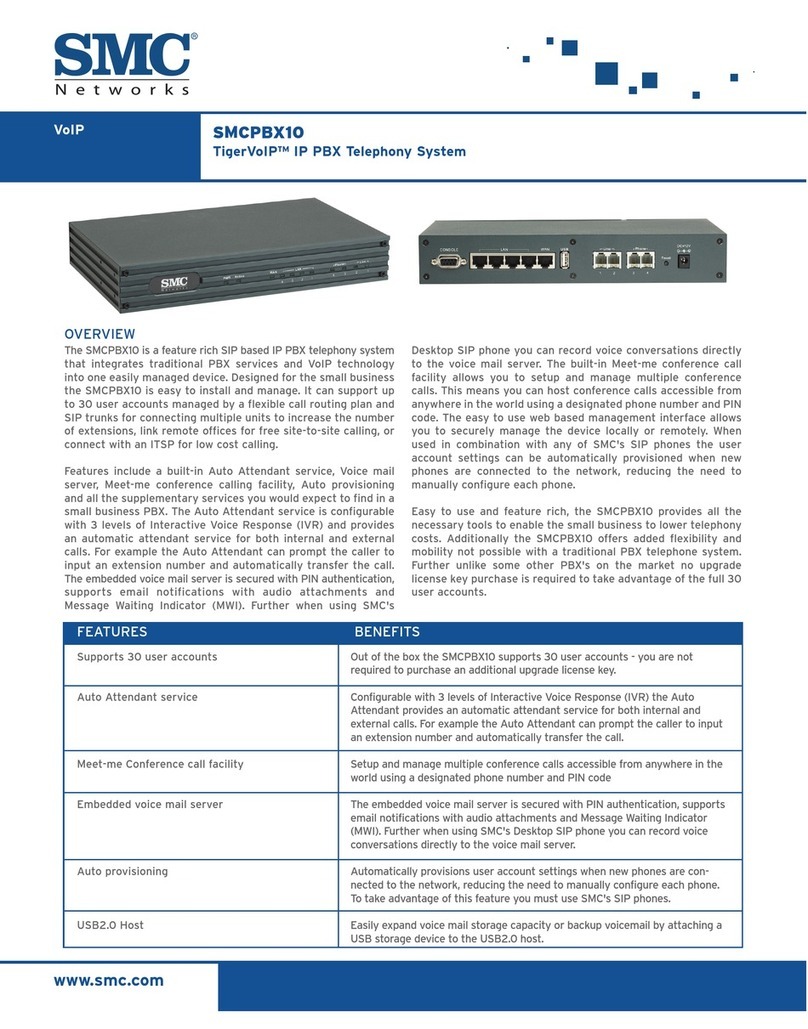
SMC Networks
SMC Networks TigerVoIP SMCPBX10 Specifications
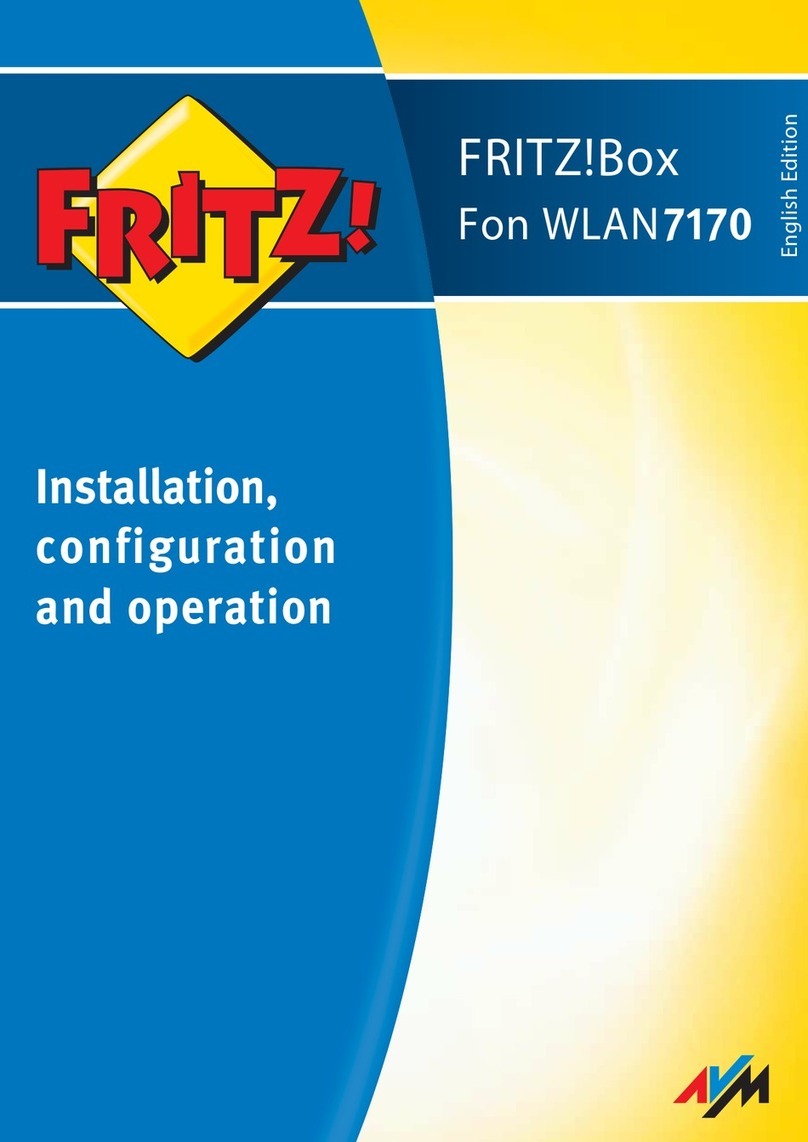
AVM
AVM Fritz!Box Fon WLAN7170 Installation, configuration and operation
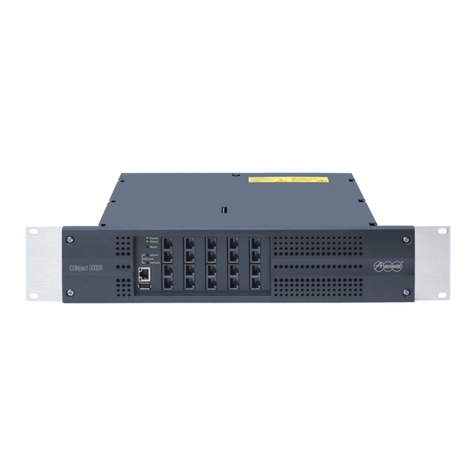
Auerswald
Auerswald COMpact 5000 Setup guide

Panasonic
Panasonic HYBRID IP-PBX KX-TDA100 installation manual
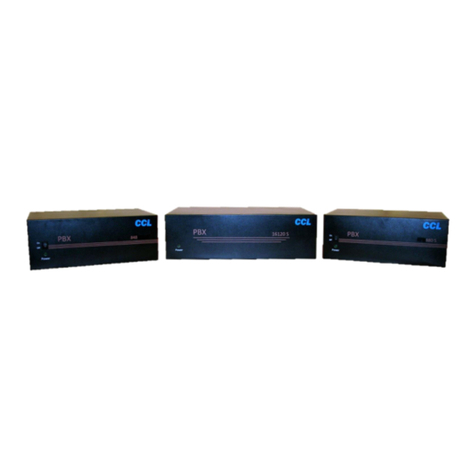
CCL
CCL COX-848S Operating & programming manual
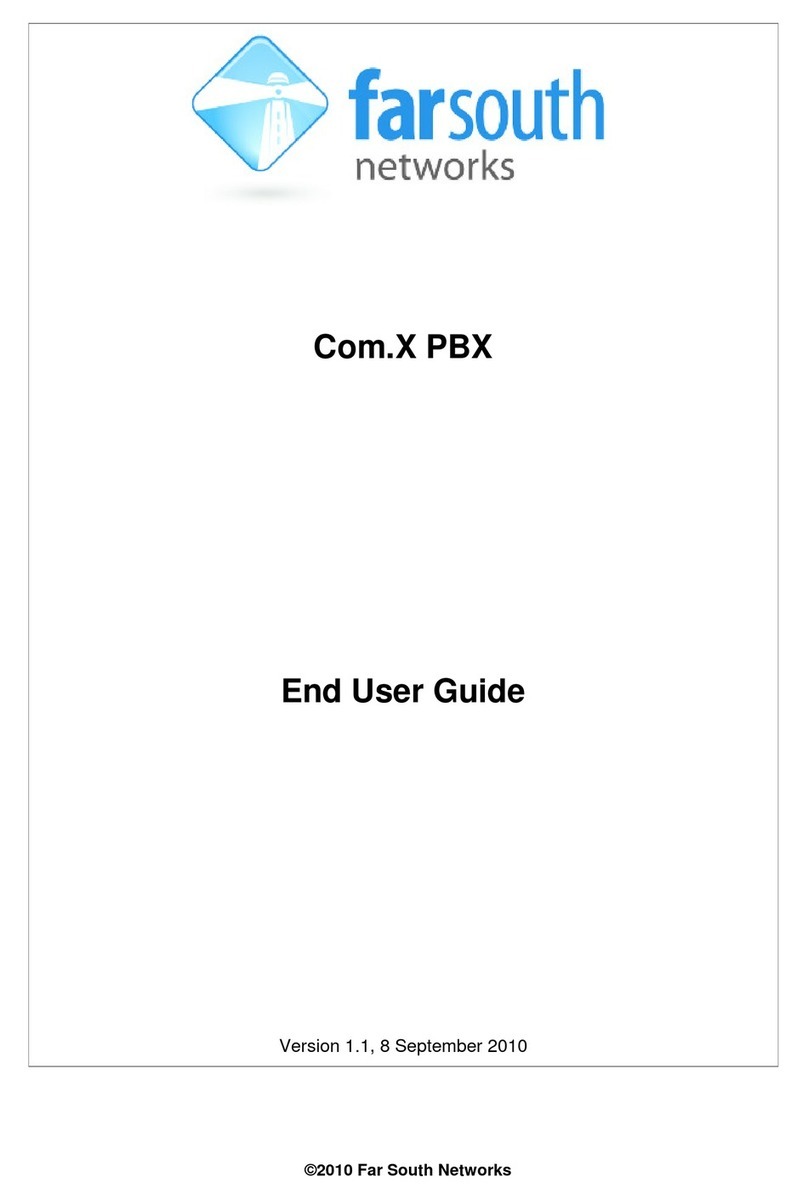
Far south networks
Far south networks Com.X PBX user guide
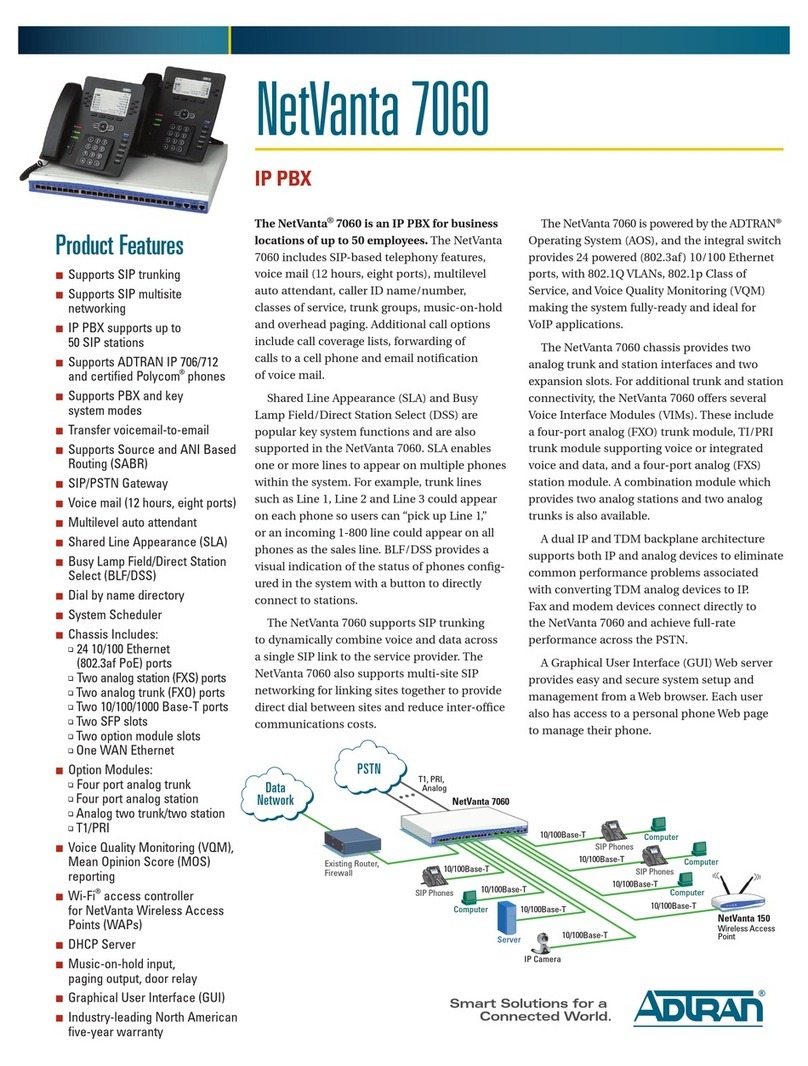
ADTRAN
ADTRAN NetVanta 7060 Product specifications
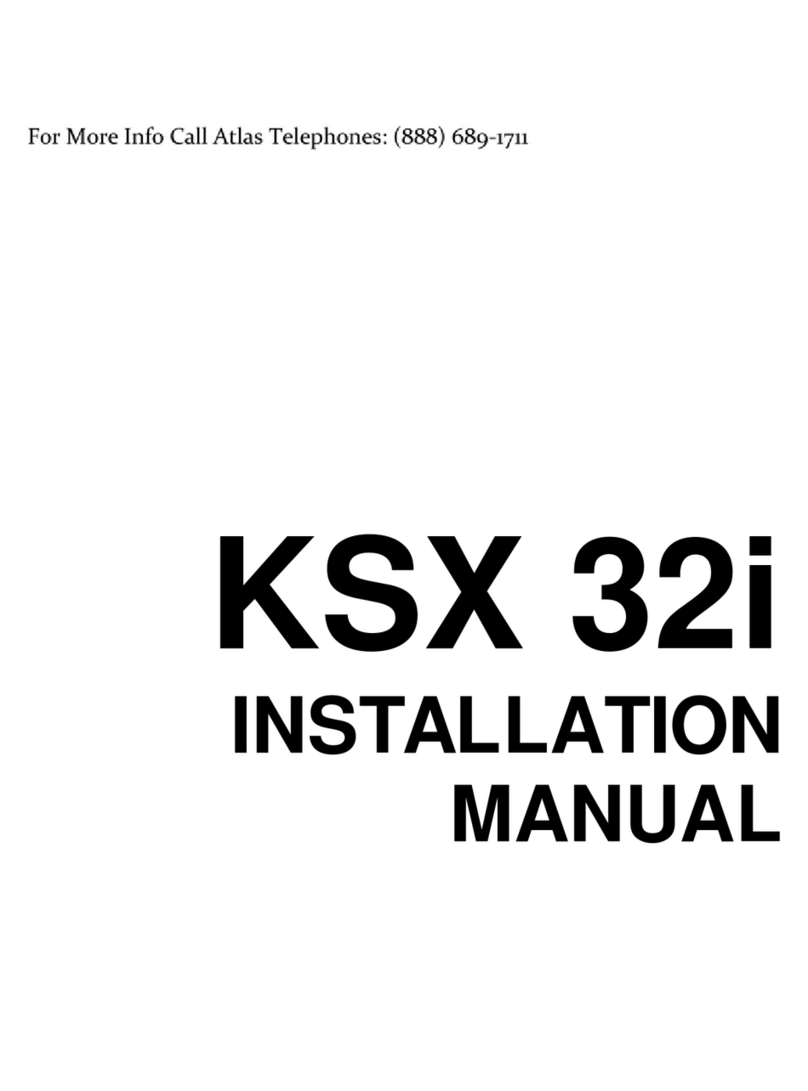
Key System US
Key System US Atlas IIE KSX 32i installation manual
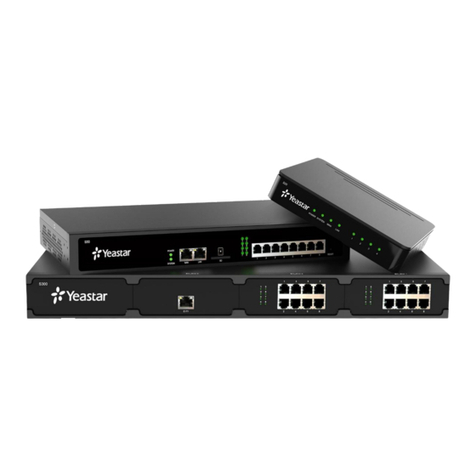
Yeastar Technology
Yeastar Technology S-Series Administrator's guide
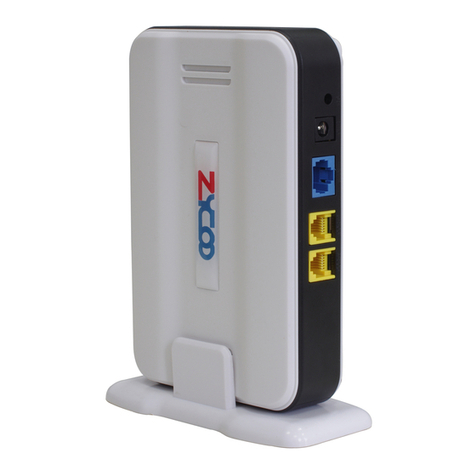
Zycoo
Zycoo ZX20 SERIES user manual

Panasonic
Panasonic KX-TDE100 installation manual

Panasonic
Panasonic KX-TD500 installation manual
